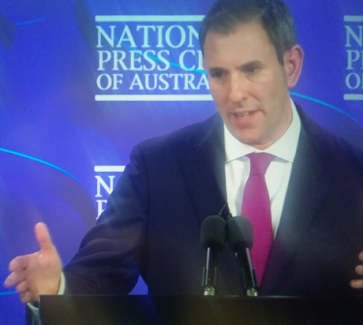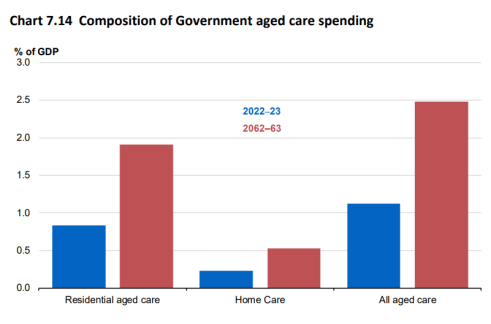
Australia’s ageing population will place further pressures on the aged care system and, in turn, government finances, warns the latest intergenerational report.
Formally released on Thursday by the Treasury, the report – the sixth of its kind – provides a “big picture view” of the nation’s fiscal position over the next 40 years.
The IGR’s authors list five core spending strains over the next four decades – among them aged care. “Australian Government spending on aged care is projected to grow,” they say.
While growth in spending on residential aged care is the main contributor to the increase, the authors say spending on community care is also projected “to rise significantly”.
As the IGR authors note, the number of people 85-plus are projected to triple by 2062-63 to more than 3.5 million people. “This will exert considerable pressure on aged care spending,” they say. Meanwhile, the number of people 65-plus is expected to more than double in 40 years.

Speaking at the National Press Club in Canberra Thursday, Treasurer Jim Chalmers said: “As we age, there will be a smaller share of working-age people, putting pressure on our tax base. At the same time we face growing spending pressures from the NDIS, aged care, health, defence and debt interest costs, which could keep us in deficit and put debt back on the rise.”
The Intergenerational Report 2023 shows life expectancies will also rise in Australia with men living to 87 years of age and women to 89.5. As well, the population will swell to more than 40 million by 2062-63.
Australia’s growing and ageing population will be the “primary driver” of aged care spending over the next 40 years, say the report’s authors.
Indeed, Australian Government spending on aged care is projected to increase as a proportion of gross domestic product from 1.1 per cent in 2022-23 to around 2.5 per cent in 2062-63.

“This is caused mainly by projected increases in spending on residential care, in line with the growth in the number of people aged 80 and over,” say the report’s authors.
They add: “Additional future demand for aged care will require funding approaches that support a fair and equitable aged care system.”
Greater consumer contributions from those who can afford to pay is a funding option currently being considered by the aged care taskforce and supported by sector stakeholders.
The report’s authors list other factors that can impact future government aged care spending:
- changes in the average cost of providing care, for example price or wage changes
- incidence of frailty, disease and disability within the population of care recipients
- changes in government policy, including the level and composition of subsidised services, regulatory settings, and the share of cost across governments and households
- changing preferences of older Australians, including ageing in the home rather than in residential care.
In a statement released earlier in the week, Mr Chalmers said Australia’s care economy will become “an even more central focus” in the decades ahead. “Whether it’s health care, aged care, disabilities or early childhood education, we’ll need more well-trained workers to meet the growing demand for quality care over the next 40 years.”

In response, Lin Hatfield Dodds – chief executive officer of The Benevolent Society – said the workforce also needs to be well paid. “We need a workforce that is paid decently and knows it is valued – it’s essential to providing quality services.”
Ms Hatfield Dodds agreed there was an urgent need to prepare the care and support sector for the huge increase in demand for services over the next 40 years. “We are far off where we need to be,” she said. “We must get the right settings in place so this sector can provide increased, improved and more reliable services to Australians.”
Ms Hatfield Dodds added: “Anyone who has followed the recent royal commissions into aged care and disability know that too many people fall through the cracks of systems that are overworked, underfunded, and overdue for structural reform.”

Also responding to the IGR, Patricia Sparrow – chief executive of advocacy group Council on the Ageing Australia – acknowledged that Australians were living longer and healthier and said: “We have to value and harness the wisdom and experience that comes with that.”
However, Ms Sparrow expressed concerns that senior Australians were being framed as a drain on the country’s finances. “Older Australians are a resource with valuable expertise and expertise that can and should be shared – without harnessing that we’re robbing every generation.”
Comment on the story below. Follow Australian Ageing Agenda on Facebook, X (Twitter) and LinkedIn, sign up to our twice-weekly newsletter and subscribe to AAA magazine for the complete aged care picture.



